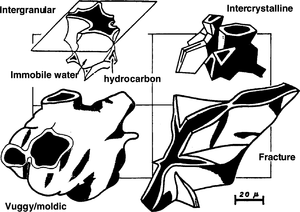Difference between revisions of "Pore system fundamentals"
Cwhitehurst (talk | contribs) |
FWhitehurst (talk | contribs) |
||
| Line 28: | Line 28: | ||
==See also== | ==See also== | ||
| − | * [[ | + | * [[Pore systems]] |
* [[Pore system shapes]] | * [[Pore system shapes]] | ||
* [[Pore and pore throat sizes]] | * [[Pore and pore throat sizes]] | ||
* [[Connectivity and pore throat size]] | * [[Connectivity and pore throat size]] | ||
| − | |||
* [[Determining pore throat size from Pc curves]] | * [[Determining pore throat size from Pc curves]] | ||
Revision as of 14:47, 22 July 2014
| Exploring for Oil and Gas Traps | |

| |
| Series | Treatise in Petroleum Geology |
|---|---|
| Part | Predicting the occurrence of oil and gas traps |
| Chapter | Predicting reservoir system quality and performance |
| Author | Dan J. Hartmann, Edward A. Beaumont |
| Link | Web page |
| Store | AAPG Store |
Porosity consists of relatively large voids, or pores, distributed among smaller passages called pore throats. A pore system is an aggregate of pores and pore throats that shares a similar morphology. These elements play a role in determining reservoir and seal petrophysics (the characteristic way that oil, gas, and water move through rocks). Figure 1 shows typical 3-D pore system geometries found in intergranular, intercrystalline, vuggy, or fractured rocks.
Critical elements of pore-system geometry
The pores of a rock occur between grains or crystals, in fractures, or in vugs. A rock's storage capacity is controlled by the size and number of pores. A rock's permeability (flow capacity) is controlled by the size, shape, and number of the pore throats (connections) per pore. Four critical elements of the geometry of a rock's pore system are
- Pore system shapes
- Pore and pore throat sizes
- Pore connectivity
- Ratio of pore throats to pores
See also
- Pore systems
- Pore system shapes
- Pore and pore throat sizes
- Connectivity and pore throat size
- Determining pore throat size from Pc curves
